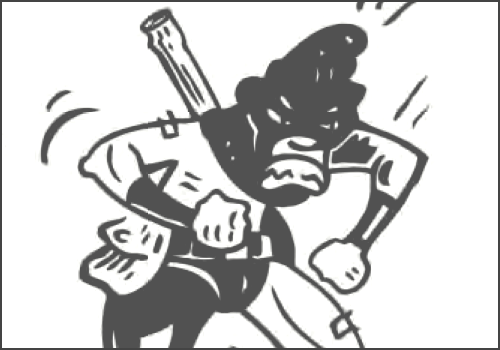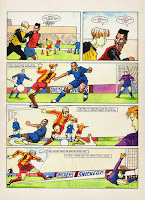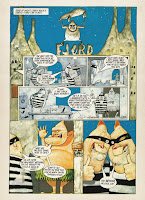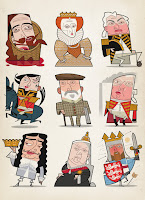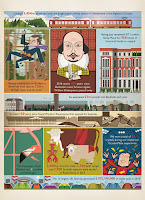The Great North Wood - Tim Bird (Avery Hill Publishing, 2018)
A thoughtfully written and wonderfully drawn graphic journey that charts the history, geography and mythology of a part of London that is often overlooked, yet amongst one of Britain's most radically developmental areas. And if you think all that doesn't sound like your cup of tea, then I'm here to tell you that this is one of the most beautiful, unique and fascinating books I have read for a very, very long time.
 |
| "I remember when this was all trees." |
You really do need to pace yourself with this book, or it will be over far too soon. Everything (and I mean everything!) within these pages is so deliberate that you need to stop and take it all in; you must read, observe, admire, contemplate... and your experience will be all the better for it.
I should begin by admitting that I am in actual fact a proud South Londoner, born and bred. Even though it used to be a terrible fucking place, I loved it! None of the territories mentioned throughout the book are therefore new to me, but do you know I never stopped before to consider how they got their names?... or where the legends originated from, or that there even were any at all for that matter. However, you don't need to be familiar with the area to enjoy this story at all. To concentrate your attention solely on its specific geographical location would be to miss the point somewhat.
 |
| Fortunately, the map doesn't extend as far down to Pratt's Bottom, in Kent. |
The narrator and protagonist of this psychogeographic novel is a woodland fox, the kind you see roaming around the dark, empty roads of suburban dwellings very late at night. But this is of course no ordinary fox, this is everyfox, and his point of view is that of a being that is as ancient as the land he inhabits. The creature observes the changes in the landscape with a naive curiosity, yet demonstrates a greater depth of wisdom than all the people that have come and gone before him.
Indeed, even whilst reading through this book, you cannot help but sometimes feel like an intruder. You get the real sense of something far greater than you could possibly ever have imagined, and even important historical events pale to insignificance in the broader scheme of things. The shift in perspective is both alarming and at the same time exhilarating, yet completely necessary and unexpectedly comforting. When you get to the last page, you will realise why.
It would be far too easy to dismiss the underlying message of this account as an environmental commentary, but it is actually far more complex than that and considerably less provocative actually. It concerns the very soul and spirit(s) of a wide expanse of woodland that defines what we now recognise as South-East London. The context of the story itself is of course not entirely specific to the location, and provides a very interesting and original way of portraying the narrative.
There are some truly memorable panels and sequences throughout this book, such as the irony of the recurring chicken takeaway box, the eerie apparition of white moose gods and goddesses, and that totally surreal part of the guy with the fox mask. Keen-eyed readers may even spot a Hitchcockian cameo appearance of the author himself and his young family, as they enjoy a walk through what remains of the forest.
 |
| Twentieth Century Fox & Chicken |
The comic is entirely hand-drawn and hand-lettered in such a beautiful, naturalistic style that it would be hard to imagine The Great North Wood having worked as well any other way, or by anybody else. It has such a delicate yet bold line to the work, that makes the art as soothing and mystical as it is abruptly descriptive. There is an organic iconography to the drawings that faithfully recreate each and every place we visit, with a spartan use of deliberately effective pen strokes.
 |
| That's not Nelson Mandela House, I've already googled it. |
Indeed, what really makes this graphic novel stand out visually is the clever use of an expertly minimalist, colour-coded palette that draws the breath as it leads the eye. The burnt orange tones act as a foreground overlay so that you are immediately encouraged to identify with the canidine protagonist, and your subconscious mind will consequently associate the same colour to other salient points of impact within each panel. The complimentary pinks not only break the pages up nicely, but are also used to depict natural elements against the harsh backdrop of blue tints which, in turn, typically represent man-made and artificial structures. White is utilised infrequently as a descriptive colour, but to imply a spirituality of great significance. Everything is ultimately tied together nicely by the strong yet unobtrusive navy blue ink; the colour of depth, wisdom, imagination and intelligence.
 |
| The call of nature within nature's call. |
After I had finished with this book, I leant it to my mum to read. As far as I know, she had never picked up a comic before in her life, yet found it totally enthralling and was still in a state of some elation when I went round to pick it up the following afternoon.
Admittedly, she had a subjective interest in the content, being from South-East London herself, and was particularly impressed by the personalised message and sketch on the first inside page (thanks Tim!). I was nevertheless assured that she had enjoyed it very much, and found it as interesting and enchanting a read as I had.
A big thanks also to my good chum Tony Esmond for being kind enough to pick me up a copy. If you want to read a proper blog about comics, then you will find him here, as always.
Be sure to order your own edition of The Great North Wood here, and check why not check out some other goodies from Avery Hill Publishing whilst you are at it.
Follow Tim Bird on Twitter, and find out more about what he's up to here.
All visual content is for demonstrative purposes only and is the property of the respective owners.








